Engineering and Hosting Adaptive Freshness-Sensitive Web
Applications on Data Centers
Wen-Syan Li Oliver Po Wang-Pin Hsiung K. Selçuk Candan
Divyakant Agrawal
NEC Laboratories America, Inc.
10080 North
Wolfe Road, Suite SW3-350, Cupertino, California 95014,
USA
Email:wen@sv.nec-labs.com
Tel:408-863-6008 Fax:408-863-6099
Copyright is
held by the author/owner(s).
WWW2003, May 20-24, 2003, Budapest,
Hungary.
ACM 1-58113-680-3/03/0005.
Abstract:
Wide-area database replication technologies and the availability of content
delivery networks allow Web applications to be hosted and served from powerful
data centers. This form of application support requires a complete Web
application suite to be distributed along with the database replicas. A major
advantage of this approach is that dynamic content is served from locations
closer to users, leading into reduced network latency and fast response times.
However, this is achieved at the expense of overheads due to (a) invalidation of
cached dynamic content in the edge caches and (b) synchronization of database
replicas in the data center. These have adverse effects on the freshness of
delivered content. In this paper, we propose a freshness-driven adaptive
dynamic content caching, which monitors the system status and adjusts
caching policies to provide content freshness guarantees. The proposed technique
has been intensively evaluated to validate its effectiveness. The experimental
results show that the freshness-driven adaptive dynamic content caching
technique consistently provides good content freshness. Furthermore, even a Web
site that enables dynamic content caching can further benefit from our solution,
which improves content freshness up to 7 times, especially under heavy user
request traffic and long network latency conditions. Our approach also provides
better scalability and significantly reduced response times up to 70% in the
experiments.
H.4Information SystemsInformation Systems Applications D.2SoftwareSoftware
Engineering D.2.8Software EngineeringMetrics[complexity measures, performance
measures]
Performance, Reliability, Experimentation
dynamic content, web
acceleration, freshness, response time, network latency, database-driven web
applications
Introduction
For many e-commerce
applications, Web pages are created dynamically based on the current state of a
business, such as product prices and inventory, stored in database systems. This
characteristic requires e-commerce Web sites to deploy Web servers, application
servers, and database management system (DBMS) to generate and serve user
requested content dynamically. When the Web server receives a request for
dynamic content, it forwards the request to the application server along with
its request parameters (typically included in the URL string). The Web server
communicates with the application server using URL strings and cookie
information, which is used for customization, and the application server
communicates with the database using queries. When the application server
receives such a request from the Web server, it may access the underlying
databases to extract the relevant information needed to dynamically generate the
requested page. To improve the response time, one option is to build a high
performance Web site to improve network and server capacity by deploying the
state of art IT infrastructure. However, without the deployment of dynamic
content caching solutions and content delivery network (CDN) services, dynamic
contents are generated on demand. In this case, all delivered Web pages are
generated based on the current business state in the database. However, when
users receive the contents, the business state could already have changed due to
the network latency. An alternative solution is to deploy network-wide caches so
that a large fraction of requests can be served remotely rather than all of them
being served from the origin Web site. This solution has the advantage of
serving users via caches closer them and reducing the traffic to the Web sites,
reducing network latency, and providing faster response times. Many CDN
services [1]
provide Web acceleration services. A study in [2]
shows that CDN indeed has significant performance impact. However, for many
e-commerce applications, HTML pages are created dynamically based on the current
state of a business, such as product prices and inventory, rather than static
information. Therefore, content delivery by most CDNs is limited to handling
static portions of the pages and media objects, rather than the full spectrum of
dynamic content that constitutes the bulk of the e-commerce web sites. Wide-area
database replication technologies and the availability of data centers allow
database copies to be distributed across the network. This requires a complete
e-commerce web site suite (i.e., Web servers, application servers, and DBMS) to
be distributed along with the database replicas. A major advantage of this
approach is, like the caches, the possibility of serving dynamic content from a
location close to the users, reducing network latency. However, this is achieved
at the expense of overhead, caused by the need of invalidating dynamic content
cached in the edge caches and synchronization of the database replicas in the
data center. How to architect Web sites and tune caching policies dynamically to
serve fresh content in short response time is a complex problem. In this paper,
we focus on the issue of how to maintain the best content freshness for a given
set of user request rate, database update rate, and network latency parameters.
We propose an freshness-driven adaptive dynamic content caching
technique that monitors response time and invalidation cycle as feedback for
dynamic adjustment of caching policy. By considering the trade-off of
invalidation cycle and response time, it maintains the best content freshness to
the users. The rest of this paper is organized as follows. In Section 2
we describe a typical data center architecture for hosting database-driven Web
application. In Section 3,
we describe how to enable dynamic content caching for data center-hosted Web
applications. In Section 4
we address some limitation of these architectures in supporting fresh dynamic
content. In Section 5,
we give an overview of our proposed solution for assuring content freshness. In
Section 6
we describe the dynamic content invalidation schemes in the scope of NEC's
CachePortal technology. In Section 7,
we describe dependency between request response time and invalidation cycles. In
Section 8
we describe how to engineer adaptive freshness-sensitive Web applications on
data centers that balances response time and invalidation cycles. We also
present experimental results that evaluate effectiveness of our proposed
technique for ensuring content freshness as well as its benefit in accelerating
request response. In Section 9
we summarize related work and compare with our approach. In Section 10
we give our concluding remarks.
Data Center Architecture for Hosting Web
Applications
A typical data center architecture for hosting Web applications
requires a complete e-commerce Web site suite to be distributed along with the
database replicas. The figure shows a configuration in which the WS/AS/DBMS
suite is installed in network edges to serve non-transaction requests
which require accesses to only read-only database replicas. In order to
distinguish between the asymmetric functionality of master and slave DBMSs, we
refer the mirror database in the data center as data cache or DB Cache. DB Cache
can be a lightweight DBMS without the transaction management system and it may
cache only a subset of the tables in the master database. Updates to the
database are handled using a master/slave database configuration: all updates
and transactions are processed at the master database at the origin site. The
scheme for directing user requests to the closest server is the same as what
typical CDNs deploy. The interactions between these software components for
hosting Web applications on data centers are summarized as follows:
- A request is directed to a nearby data center based on network
proximity.
- If the request is non-transaction and the DB Cache has all the required
data, the request is processed at the data center and the result page is
generated dynamically and returned to the user.
- Otherwise, the request is forwarded to the master database at the original
site.
- The changes of database contents are periodically migrated from the master
database to the DB Cache at the data centers.
Figure 1: Data Center-hosted
Database-driven Web Site with Deployment of CachePortal
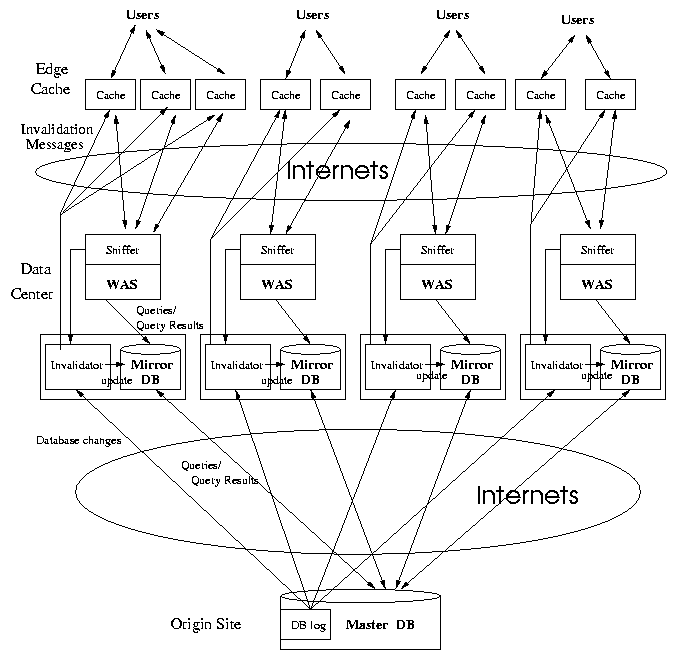
|
Either a pull- or a push-based
method can be used to synchronize DB Cache with the master database. A typical
production environment will employ a hybrid approach in which a complete refresh
is done at a coarser granularity (e.g., once in a day) and incremental refresh
is done at a finer granularity (e.g., once every hour). In most of e-commerce
Web applications, the content freshness needs to be assured at a much higher
standard and asynchronous update propagation is used. Although its popularity,
this system architecture has the following drawbacks:
- all dynamic content pages have to be generated at the data centers or the
origin Web site as user requests arrive;
- only network latency between the data centers and origin Web site is
reduced; the network latency between users and the data centers remain the
same; and
- synchronization is pre-scheduled and the dynamic content pages may be
generated based on outdated database content between two
synchronizations.
Proposed System Architecture
In [3],
we presented a theoretical framework for invalidating dynamic content. These
works introduce two new architectural components:
- sniffer: sniffer components are installed at the WAS and the
master database. The sniffer at the WAS is responsible for creating the
mappings between the URLs (identifications of pages requested) and the query
statements issued for the pages requested. The sniffer at the master database
is responsible for tracking the database content changes.
- invalidator: invalidator is responsible for the following two
tasks: (1) retrieving the database content change log from the sniffer at the
master database and propagating the changes to the mirror database; (2)
performing invalidation checking for the cached pages at the edge caches based
on the database content change log, URL and database query mapping, and the
content in the mirror database.
Note that the knowledge about
dynamic content is distributed across multiple servers. In contrast to the other
approaches [4,5]
which assume such mappings are provided by system designers, the construction of
mapping between the database content and the corresponding Web pages is
automated. In this paper, we build on these results by developing a
novel system architecture that accelerates data center-hosted Web applications
through deployment of dynamic content caching solutions. The proposed system
architecture is shown in Figure 1.
It is similar to the typical data center architecture except the two new
software modules. The interactions between the components in the data
center-hosted Web site with edge caches are as follows:
- A request is directed to the edge cache closest to the user based on the
network proximity. If there is a cache hit, the requested page is returned to
the user. Otherwise, the request is forwarded to the WAS in the closest data
center.
- If the request is non-transaction and the DB Cache has all the required
data, the request is processed and the page is generated dynamically and
returned to the user.
- Otherwise, the request is forwarded to the master database at the original
site.
- The changes of database contents are periodically reflected from the
master database at the origin Web site to the DB Cache at the data center for
synchronization and invalidation. In our implementation, database update log
is scanned every second and the new log is copied to the data center.
- The invalidator reads the unprocessed database update log and performs the
invalidation checking and synchronization tasks. These tasks are done as an
invalidation/synchronization cycle. After one cycle is completed, the
invalidator starts the next cycle immediately. Since the log scanning and
invalidation/synchronization are performed in parallel, the invalidator does
not need to wait for the completion of log scanning. We visualize the
relationship among log scanning, edge cache invalidation, and DB Cache
synchronization in Figure 2.
- The dynamic content pages generated are cached in the edge
caches.
As shown in Figure 1,
a data center may deploy multiple edge caches depending on the user request
rates. Dynamic content pages in the edge caches may be generated by the database
content in the DB Cache or the master database. The IP addresses of edge caches
and URL strings of cached pages are tracked by the invalidator for invalidation
if it is applied.
The parameters that have an impact on the resulting freshness
of delivered contents as follows: Response time at edge cache servers:
This is the round trip time for requests that are served by an edge cache server
(as a result of a cache hit). The response time from edge caches is expected to
be extremely fast. Response time at the data center: This is the round
trip time for requests that are served by a data center (as a result of an edge
cache miss and DB Cache hit). The response time from the data center is expected
to be fast, but is impacted by the request rate at the data center. The network
latency between the end users and the data center has limited impact to the
response time since the network latency is low.
Figure 2: Visualization of the
Relationship Among Log Scanning, Edge Cache Invalidation, and DB Cache
Synchronization
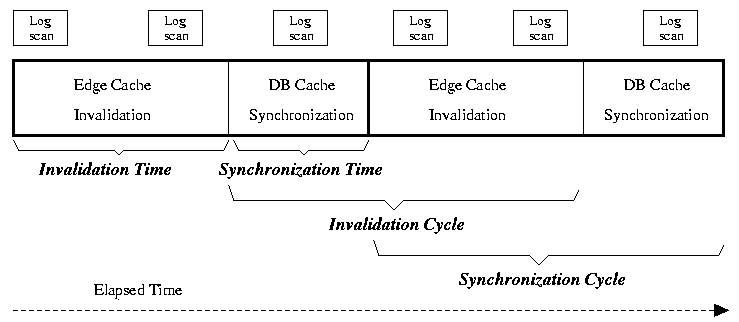
|
Response time at origin Web
sites: This is the round trip time for requests that are served at the
origin Web servers (as a result of an edge cache miss and a DB Cache miss).
Invalidation time: This is the time required to process invalidation
checks for all the pages in the edge caches. Synchronization time: This
is the time required to propagate database updates from the master database log
to the DB Cache in the data center. Invalidation cycle: This is the
time required to process invalidation checks for all the pages in the cache
servers plus propagating database updates. Note that the invalidation
process requires the database update log and synchronization of the master
database and DB Cache. Synchronization cycle: The synchronization time
could be shorter than the invalidation time; however, the synchronization cycle
is the invalidation time plus synchronization time since synchronization and
invalidation are interleaved. Note that the invalidation time and
synchronization time vary very little from one cycle to the other, the length of
synchronization cycle and invalidation cycle are almost of the same (as shown in
Figure 2)
although the length of the synchronization time and invalidation time are
different.
A data center architecture
with deployment of CachePortal has the following advantages:
- serving cached dynamic content pages is much faster than generating pages
on demand;
- edge caches are deployed close to the end users; consequently, the network
latency between end users and data centers is eliminated;
- since a bulk of the load is distributed to the edge caches, the WAS and
the DB cache at the data center have lighter loads and thus they can generate
requested pages faster.
- freshness of pages cached in the edge caches and those generated at the
data center on demand is assured to be not older than the
invalidation/synchronization cycle.
Since the freshness that can be
provided depends on the length of the invalidation/synchronization cycle, on the
other hand, this parameter has to be carefully adjusted. In the next section, we
discuss challenge in greater detail.
Issues in Content Freshness
Figure 3: Response Time and Freshness
of Delivered Content by Various Existing System Architectures
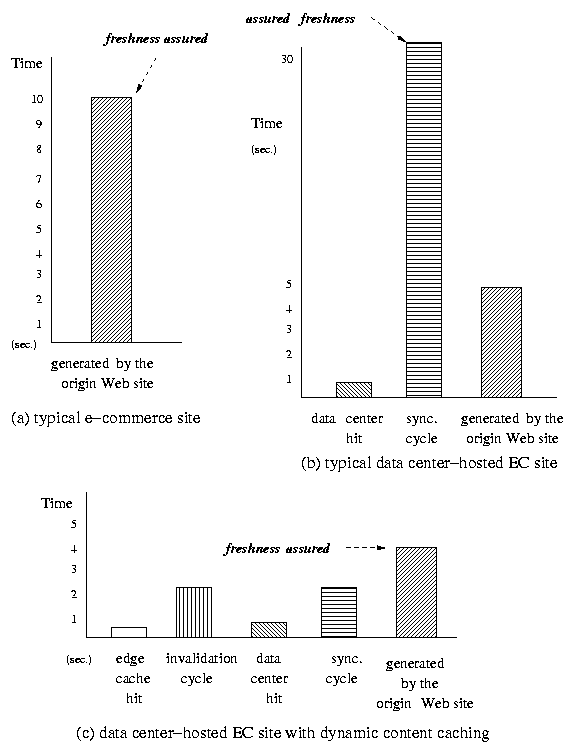
|
In Figure 3,
we illustrate response time and content freshness of three system architectures.
For Web sites that do not deploy any dynamic content caching solution (Figure 3(a)),
all pages need to be dynamically generated at the origin Web site. The content
freshness such a system can assure is the response time at the Web sites. For
example, if the average response time at a Web site is 10 seconds, even every
Web page is generated based on up to date information in the database, the
assured content freshness (i.e., age) of this Web site is 10 seconds
since the database content may change after the Web page is generated. For data
center-hosted applications, as described in Section 2,
response time can be improved by caching database content at the data centers
(benefiting from lower network latency). However, in this case, database content
must be synchronized in a timely manner so that pages are not generated based on
outdated DB Cache content. The content freshness assured by this system
architecture, then, is the maximum value among (1) DB Cache synchronization
cycle, (2) response time at the data center, and (3) response time at the master
database. For example, a DB Cache is set to be synchronized every minute (Figure
3(b))
and contents are served at both the data center and the origin Web site.
Although the response time at the data center and the origin Web site could be
as fast as less than 1 second and few seconds, respectively, the DB Cache
content may be out of synchronization as long as 30 seconds. Therefore, the
assured freshness of the delivered content is 30 seconds; even the average
response time at the data center could be as low as few seconds. For a data
center that deploys dynamic content caching solutions, as shown in Figure 1,
requested pages may be delivered from the edge cache servers; or dynamically
generated at the data center or the origin Web site. The dynamic pages in the
edge caches need to be invalidated and the content in the DB Cache needs to be
synchronized periodically to ensure the freshness of delivered content. In this
architecture, the content freshness that can be assured is the maximum
of (1) the response time from origin Web sites; (2) the response time from edge
caches; (3) the response time at the data center; (4) the edge cache
invalidation cycle; and (5) the DB Cache synchronization cycle. Note that since
the response time from the edge caches and data centers is much lower than the
response time from the origin Web site, the invalidation cycles for the edge
cache content, and the synchronization cycle of DB Cache, the content freshness
that can be assured is the maximum of (1) the response time at origin Web sites;
(2) the invalidation cycle of edge cache content; and (3) the synchronization
cycle of DB Cache content. This is illustrated in Figure 3(c).
As we can see in Figure 3,
the system architectures of a typical Web site and data center-hosted Web
applications are not suitable for applications that require assurance on the
response time and it is difficult to estimate the TTL (Time To Live).
Solution Overview
Figure 4: Response Time and Freshness
of Delivered Content with Deployment of Freshness-driven Adaptive
Caching
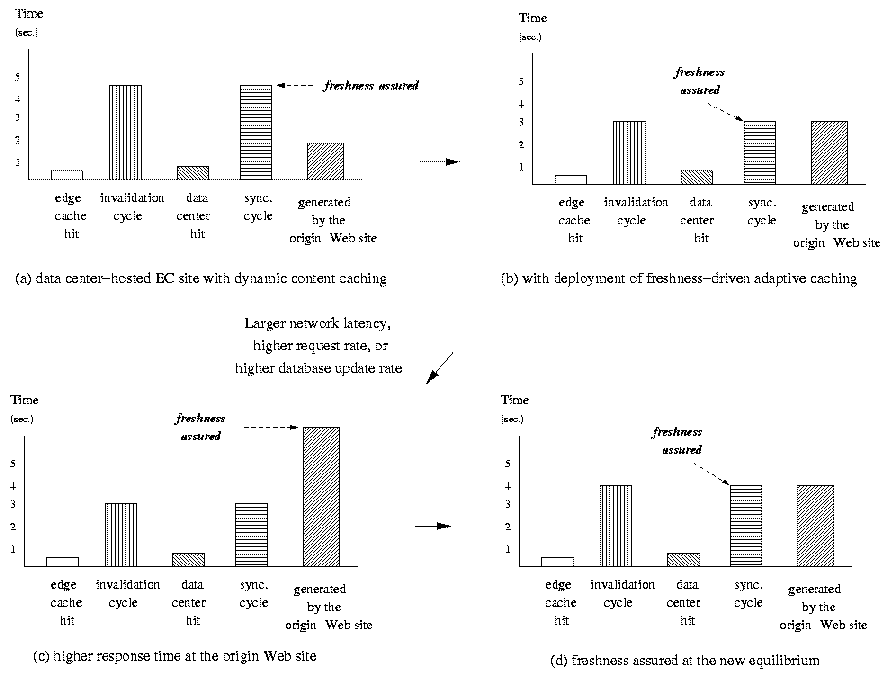
|
In Figure 3(c),
we show a system configuration that caches few pages or database content. As a
consequence, it is expected to have a short invalidation cycle and DB Cache
synchronization time; at the expense of slow response time at the origin Web
site when there is a cache miss at the edge caches and DB Cache. On the other
hand, the system configuration in Figure 4(a)
has a different caching policy that caches a large number of Web pages at edge
caches and/or more database content at the DB Cache. This configuration provides
fast response time: when there is a cache hit, the response time is naturally
very fast; when there is a cache miss, the response is still reasonable as the
Web site has lighter work load since most of the requests are served directly
from the edge cache servers or DB Caches. However, this configuration and its
caching policy has potentially low content freshness since it will take longer
time to complete the necessary invalidation check for all the pages in the edge
caches and to synchronize the DB Caches in the data centers. In this paper, we
propose a freshness-driven adaptive dynamic content caching technique.
The proposed technique aims at maintaining the best content freshness that a
system configuration can support and assure. Our technique does not blindly
attempt to maintain the lowest average response time nor average content
freshness. Instead it dynamically tunes the caching policy: the hit rate is
tuned to a point where the response time from the origin site and invalidation
cycle for the cached pages are equivalent as shown in Figure 4(b).
At this point, the freshness of requested pages can be ensured to be at the
highest level. For the configuration in Figure 4(b),
the content freshness that can be assured is equal to the length of the the edge
cache invalidation cycle (or the DB Cache synchronization cycle). Given that the
response time at the origin Web site is lower, the proposed freshness-driven
adaptive caching would tune its caching policy by decreasing the number of
cached pages and database content so that the edge cache invalidation cycle and
DB Cache synchronization cycle get shorter accordingly. The number of cached
pages and database content are decreased until the response time at the origin
Web site is close to the invalidation cycle (and synchronization cycle) as shown
in Figure 4(b).
At this equilibrium point, the assured freshness of delivered content is
optimal. In addition, the response time at the Web site is also assured. Thus,
in Figure 4(b),
the freshness of dynamic content and response time for the Web site are assured
to be less than 3 seconds. The equilibrium point in Figure 4(b),
however, may change when the values of the influential system parameters change.
If network latency, database update rates, and user request rates increase, the
response time at the origin Web site will increase accordingly (Figure 4(c)).
To reduce the response time at the origin Web site, the freshness-driven
adaptive caching will increase the number of cached pages at the edge cache
and/or database content at the DB Cache. Consequently, the request rate at the
origin Web site would be reduced (so would be the response time) at the expense
of invalidation cycle and synchronization cycle. Note that the equilibrium point
in Figure 4(d)
is higher than the equilibrium point in Figure 4(b).
The proposed freshness-driven adaptive caching has various advantages. First, it
yields and assures the best content freshness among these system architectures.
Second, it also yields fast response times. Third, it provides assurance for
both freshness and response time as follows:
- the system does not serve the content that is older than the assured
freshness; and
- the system does not serve the content slower than the assured response
time.
Invalidation Checking Process
In this
section, we describe the invalidation schemes used in the proposed system
architecture. Assume that the database has the following two tables:
Car(maker, model, price) and Mileage(model, EPA). Say that the
following query, Query1, has been issued to produce a Web page,
URL1: select Car.maker, Car.model, Car.price, Mileage.EPA
from Car, Mileage
where Car.maker = "Toyota" and
Car.model = Mileage.model;
Now a new tuple (Totota, Avalon, $25000) is inserted
into the table Car. Since Query1 accesses two
tables, we first check if the new tuple value can satisfy the condition
associated with only the table Car stated in
Query1. If it does not satisfy, we do not need to test the other
condition and we know the new insert operation does not impact the query result
ofQuery1 and consequently URL1 does not need to be
invalidated or refreshed. If the newly inserted tuple does satisfy the condition
associated with the table Car, we cannot determine whether or not
the query result of Query1 has been impacted unless we check
the rest of the condition associated with the table Mileage. To
check whether or not the condition Car.model = Mileage,model can be satisfied, we need to access the table Mileage.
To check this condition, we need to issue the following query,
Query2, to the database: select Mileage.model, Mileage.EPA
from Mileage
where "Avalon" = Mileage.model;
If the result of Query2 is non-empty, the query result for
Query2 needs to be invalidated. The queries, such as
Query3, that are issued to determine if certain query results need
to be invalidated are referred as polling queries. Now assume that we
observe the following three queries, Query3 and
Query4, in the URL/database query mapping to generate user
requested pages: select maker, model, price
from Car where maker = "Honda";
select maker, model, price
from Car where maker = "Ford";
we can derive a query type,
Query_Type1 as: select maker, model, price
from Car
where maker = $var;
Therefore, multiple query instances can have the
same bound query type; and, multiple bound query types may have the same query
type. We can create a temporary table Query_Type to represent the above
two query instances as follows:
QUERY_ID QUERY_INSTANCE
---------- ------------------
Query3 Honda
Query4 Ford
---------- ------------------
Let us also assume that the following four tuples
are inserted to the database: (Acura, TL, $30000)
(Honda, Accord, $20000)
(Lexus, LS430, $54000)
A temporary table Delta to represent the
above three tuples. We can consolidate a number of invalidation checks into more
compact form through transformation. For example, a single polling query,
Query5 , can be issued as follows: select Query_Type.QUERY_ID
from Car, Query_Type, Delta
where Delta.Maker = Query_Type.QUERY_INSTANCE;
Query_Type.QUERY_ID is a list of query results that need to
be invalidated. In this example,Query3 will be invalidated.
For details of the invalidation scheme, please see [6].
We summarize important characteristics of the consolidated invalidation checking
schemes as follows: (1) the invalidation cycle is mainly impacted by the number
of cached query types since it determines the number of polling queries executed
for invalidation checking; and (2) database update rates and the number of query
instance per query type would have relatively lower impact on the invalidation
cycle since they only increase query processing cost.
Dependency between Response Time and
Invalidation Cycle
In this section, we examine the dependency between the
response time and the invalidation cycle length. We have conducted experiments
to verify this dependency. We first describe the general experiment setup that
consists of Web servers, application servers, DBMS, and network infrastructure
that are used in the experiments.
We used two heterogeneous networks that are
available in the NEC's facility in Cupertino, California: one is used by the
C&C Research Laboratories (referred to as CCRL) and the other one is used by
cacheportal.com (referred to as CP). Users, edge cache servers, Web
server, application server, and DB Caches are located in the CP network while
the master databases are located in the CCRL network. The average round trip
time on the CCRL-CP connections is around 250 ms while the round trip time
within the same network is negligible. To summarize, connectivity within the
same network is substantially better than that across the Internet and there is
notable network latency. BEA WebLogic 7.0 is used for the WAS. Oracle 9i is used
as the DBMS. The database contains 7 tables with 1,000,000 rows each. The
database update rate is 600 rows per table per minutes. The Squid server is
modified to use as edge cache servers. The maximum number of pages that can be
cached is 1,000,000 pages. These pages are generated by queries that can be
categorized into 1,000 query types. Thus, on average, there are 1,000 pages
(query instances) per query type. Among these 1,000 query types, 200 query types
are non-cacheable (i.e. queries involved transactions, privacy, or security).
All servers are located in dedicated machines. All of the machines are Pentium
III 700Mhz one CPU PCs with 1GB of memory. They are running Redhat Linux 7.2.
Correlation between Number of Cached Query
Types and Edge Cache Hit Rates
The problem of cache replacement has been
extensively studied. Many algorithms have been proposed for general purpose
caching, such as LRU and LFU. Some variations of these are designed specifically
for cache replacement of Web pages. However, in the scope of dynamic caching for
a Web site, cache invalidation rate is an important factor since a high
invalidation rate will lead to a potentially high cache miss rate in the future.
Another consideration is that there is overhead for invalidation checking
process; a well-tuned cache management should cache only a small portion of
pages to serve most of the requests.
Figure 5: Correlation between Number of
Cached Query Types and Load Distribution
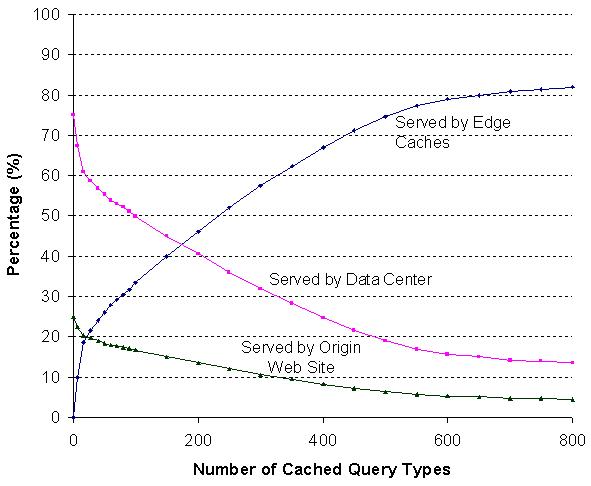
|
We have developed a cache
replacement algorithm that takes into consideration (1) user access patterns,
(2) page invalidation pattern, (3) temporal locality of the requests, and (4)
response time. Consequently, we are able to select only a small number of query
types (i.e., pages generated by these query types) to cache, but maintain a high
hit rate at edge caches. Figure 5
shows the correlation between the number of selected cached query types
and the request distribution percentages in the edge caches, data centers, and
origin Web site. As we can see in the figure, when we choose to cache 200 query
types (25% of all query types), the cache hit rate is close to 48%. However,
when we increase cached query types from 500 to 800, the cache hit rate can only
be improved by an additional 5%. Note that user requests are distributed among
edge caches, data centers, and the origin Web site. Thus, when there is a high
edge cache hit rate, the load at both the data center and the master database is
reduced. The figure shows that approximately 75% of the user requests due to
edge cache miss can be handled by the data center and the master database
handles the rest 25% of the requests, including requests due to edge cache
misses and data center misses, as well as all transactions. The ratio of 75%:25%
is independent from the edge cache hit rate.
Effects of Request Rates and Cache Hit Rates
on Request Response Time
Figure 6: Effects of Request Rates and
Number of Cached Query Types on Request Response Time at the Data
Center
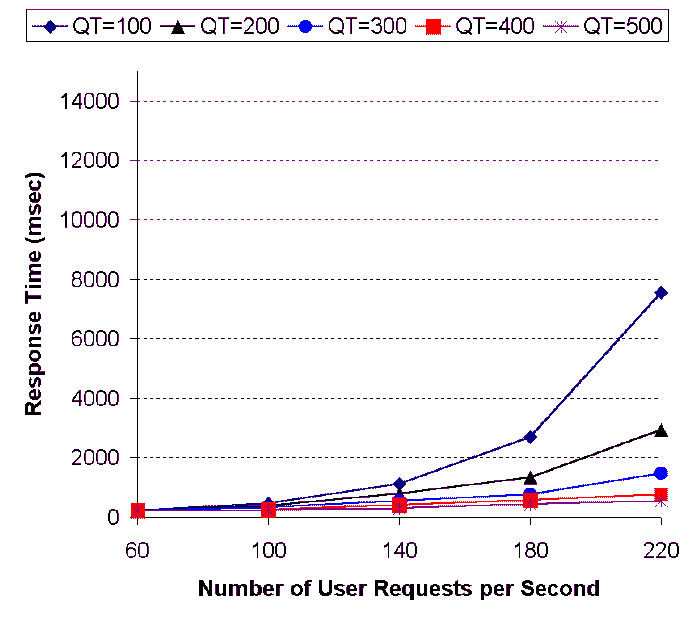
|
Figure 7: Effects of Request Rates and
Number of Cached Query Types on Response Time at the Origin Web Site

|
The next experiment we conducted
is to measure the effects of cache hit rates (i.e., number of cached query
types) and request rates on the response time. Note that we do not present the
effects of cache hit rates and request rates on the response time at the edge
cache server since the response time at edge cache server fast. In Figures 6
and 7,
we plot the response time at the data center and the origin Web site with
respect to various request rates (i.e., from 20 to 120 requests per second) and
numbers of cached query types (i.e., from 100 to 500). The experimental results
indicate the following:
- the origin Web site is much more sensitive to the request rate than the
data center caused by the network latency between the users and the origin Web
site. The master database needs to keep more connections open for a longer
period and many requests are queued waiting for processing.
- the response time at the origin Web site is higher than that at the data
center. This is also due to the network latency;
- when the request rate reaches a certain threshold, the response time
increases sharply. We observe this effect in both figures. This is because the
requests start to accumulate after the request rate reaches a certain level;
and
- the response time is reduced when the number of cached query types is
increased. We observe such effects in both figures (at the data center and the
origin Web site).
Effects of Network Latency on Request
Response Time at the Origin Web Site
Figure 8: Effects of Request Rates and
Network Latency on Request Response Time at the Origin Web Site
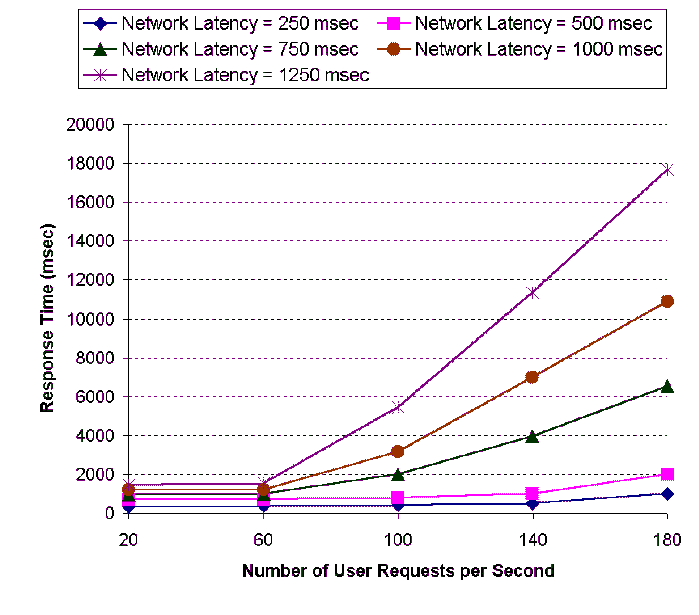
|
In earlier experiments, the
network round trip latency between users and the origin Web site was set around
250 ms. In this experiment, to measure the effects of network latency, we fixed
the edge cache hit rate (i.e. the number of cached query type) but varied the
request rate and the network latency between users and the origin Web site. The
round trip time is altered as 250 ms, 500 ms, 750 ms, 1000 ms, and 1250 ms. In
Figure 8,
we plot the response time at the origin Web site with respect to a set of
different user request rates and network latency settings. The experimental
results in the figure indicate that request response time at the origin Web site
is very sensitive to the request rate and network latency when the user request
rates reach a certain level. When the request rate and network latency reach a
certain threshold, the response time increases sharply. Again, this is because
request accumulation frequently occurs while the system experiences heavy
request load and long network latency. We also observe that the response time
increases at a faster rate with longer network latency; as we can see from the
figure, the slope of the plot for the network latency of 1250 ms is much steeper
than that for the network latency of 250 ms.
Freshness-driven Caching
In this section,
we describe the proposed freshness-driven adaptive dynamic content caching
followed by the discussion and analysis of the experimental results.
To achieve the best assured dynamic content freshness, we
need to tune the caching policy so that the response time is close to the
invalidation cycle in an equilibrium point. However, the response time and
invalidation cycle can only be improved at the expense of each other. In Section
7,
we found that response time can be impacted by (1) network latency, (2) user
request rates, (3) database update rates, (4) invalidation cycle (frequency),
and (5) edge cache hit rates. Network latency, request rates, and database
update rates depend on the network infrastructure and application
characteristics and hence can not be controlled. However, we can tune the edge
cache hit rate (to a certain degree) by adjusting the number of cached query
types; and consequently affect response time. Figure 9
summarizes the effect of the number of query types on response time,
invalidation cycle, and synchronization cycle. In this configuration, the
database update rate is 120 updates per second and user request rate is 105
requests per second. We vary the number of cached data types between 50, 100,
200, 300, 400, and 500. We plot the response time at the edge cache, data
center, and origin Web site. We also plot the length of the invalidation and
data center synchronization cycle (note that the invalidation cycle and data
center synchronization cycle are identical since invalidation and
synchronization are performed together). When the number of cached query types
decreases from 500 to 100, the invalidation/synchronization cycle and response
time at the origin Web site move to an equilibrium point. At the equilibrium
point (i.e., QT=100), the assured freshness is higher than the response times at
the edge cache and the data center. Since the response times at the edge cache
and data center are much lower than the response at the origin Web site, ![$1.2$]() seconds is the best
freshness we can assure. The value will increase when the network latency
between users and the origin Web site or user request rate increase and vice
versa.
seconds is the best
freshness we can assure. The value will increase when the network latency
between users and the origin Web site or user request rate increase and vice
versa.
Figure 9: Effects of the Number of
Cached Query Types on Response Time and Invalidation/Synchronization
Cycle
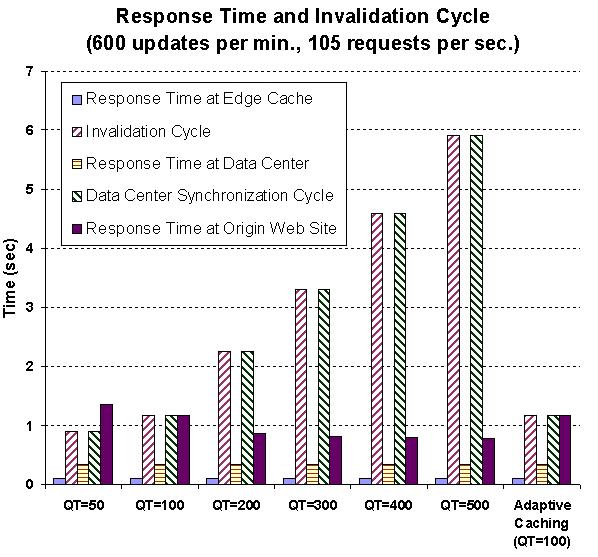
|
We derive the following adaptive
caching policy for maintaining request response time and invalidation cycle
close to an equilibrium point:
- If the response time at the origin Web site is larger than the length of
the invalidation cycle, the response time can be reduced by increasing the
number of cached query types until the request response time and invalidation
cycle reach an equilibrium point. Note that when we increase the number of
cached query types, the edge cache hit rate will increase. As a result, the
request rates at the data center and the origin Web site are reduced.
Consequently, the response time at both the data center and the origin Web
site is improved.
- Similarly, if the invalidation cycle is longer than the request response
time, we can lower the invalidation cycle by decreasing the number of cached
query types until the request response time and invalidation cycle reach an
equilibrium point.
In the current implementation, the adaptive caching
policy is deployed at the edge server. The response time is measured at the
cache server assuming that the round trip between users and the cache server
(i.e., functioning as a user side proxy) is negligible.
Figure 10: Impact of Adaptive Caching
on Content Freshness
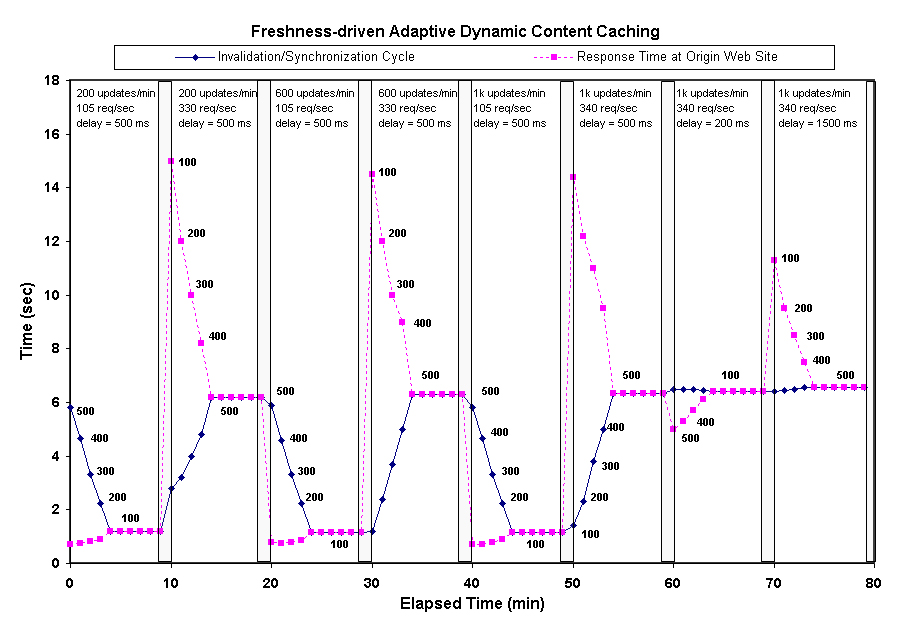
|
Figure 11: Comparisons of Assured
Content Freshness for Three System Configurations
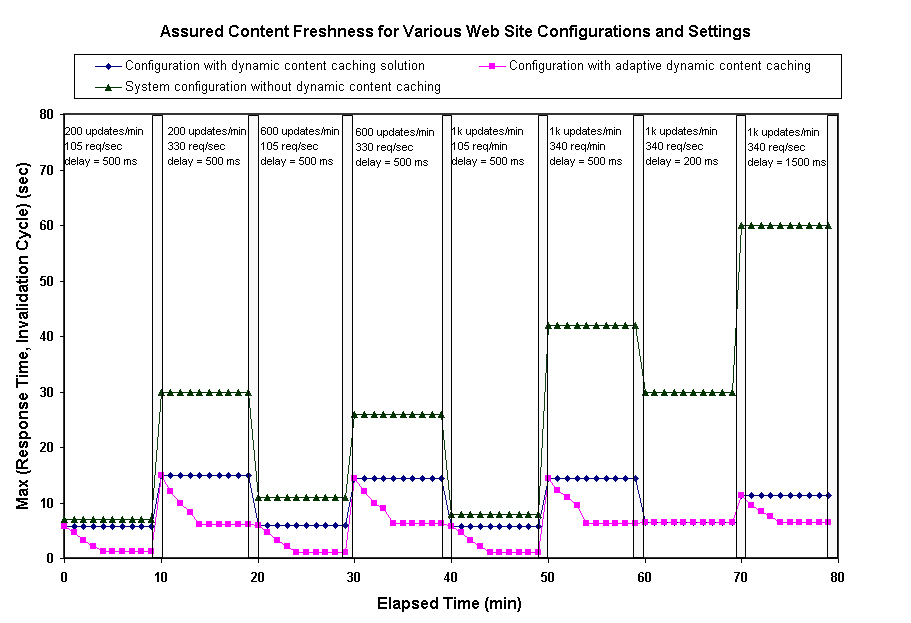
|
We conducted a series of
experiments to evaluate the proposed freshness-driven adaptive dynamic content
caching technique. In these experiments, we created setups by varying request
rates and database update rates (every 10 minutes) for the first 60 minutes of
experiment. In the first 60 minutes, the network latency is stable at 500 ms
delay on average. After 60 minutes, the database update rate and request rate
are fixed while the network latency is varied. We observed the effects of our
freshness-driven adaptive caching technique on maintaining the best freshness
that can be assured for a given system configuration and setup. In Figure 10,
we plot the response time at the origin Web site as a dotted line and
invalidation cycle as a solid line. The numbers next to the dotted line are the
number of cached query types. In this figure, we do not plot the response time
at the edge cache and the data center since the response times are very low. The
response times measured are the response time at the origin Web site. A sudden
change in the request rate and network latency will cause temporary imbalance of
response time (at the origin Web site) and invalidation/synchronization cycle
(at the edge caches and the data center). As the imbalance is detected, the
freshness-driven adaptive caching technique makes necessary adjustments to the
number of cached query types, and this impacts the cache hit rate and the
response time. As time elapses, the response time and invalidation cycle shifts
to a new equilibrium point which supports the best content freshness that can be
assured. For example, when the database update rate suddenly changes from 40
updates per second to 120 updates per second at 20th minute of the experiment,
the number cached query types is decreased to 100, where a new equilibrium point
is reached. This compensates the sharp increase of invalidation/synchronization
cycle due to the additional 80 updates per seconds; the number cached query
types is decreased to 100. The request response time at the origin site can be
adjusted fairly quickly since it is very sensitive to the cache hit rate. And,
we also observe in all our experiments that when we change the number of cached
query types to compensate temporary imbalance of response time and invalidation
cycle, both response time at the origin Web site and invalidation cycle moves
toward a new equilibrium point at the same time. The observations in the
experiments are consistent with our experimental results in Section 7.
Next, we
compare the content freshness that can be assured by four system configurations
as follows:
- a data center that does not deploy any dynamic content caching
solution;
- a data center with dynamic content caching but the numbers of cached query
types are preset as 200;
- a data center with dynamic content caching but the numbers of cached query
types are preset as 400; and
- a data center that deploys dynamic content caching and the proposed
freshness-driven adaptive caching technique.
In Figure 11
we plot the larger of the response time and the invalidation/synchronization
cycle length at data centers of the four system configurations. This value gives
the content freshness that a given system configuration can support for given
request and database update rates. In the middle of each period in the figure,
we indicate the ranking of four configurations in term of freshness they assure
(the lower the better). The figure shows the huge benefit provided by deploying
Cacheportal. The three configurations with CachePortal (i.e., QT200, QT400, and
Dyna) consistently provides much fresher content than the typical data center
configuration. Especially, during the heavy traffic conditions in the periods of
10-20, 30-40, and 50-60 minutes and the long network latency delay condition in
the period of 70-80 minutes, the system configuration with the freshness-driven
adaptive caching supports content freshness up to 15 times better than those of
the typical data center. As we can see, some time (i.e., the periods of 10-20,
30-40, 50-60, and 70-80 minutes) the configuration 2 (QT200) performs better
than the configuration 4 (QT400) and opposite is true in other times (i.e., the
periods of 0-10, 20-30, and 40-50 minutes). However, the adaptive caching can
consistently tune the caching policy to provide the best assured freshness
feasible for a specific set of conditions and system configuration. In our
experiments, the adaptive caching supports content freshness up to 10 times
better than even those systems that already deploy dynamic content caching
solutions. The experiments strongly show the effectiveness and benefits of the
proposed freshness-driven adaptive caching technique in providing fresh dynamic
content.
Figure 12: Response Time of Data
Center-hosted Web Applications with and without CachePortal
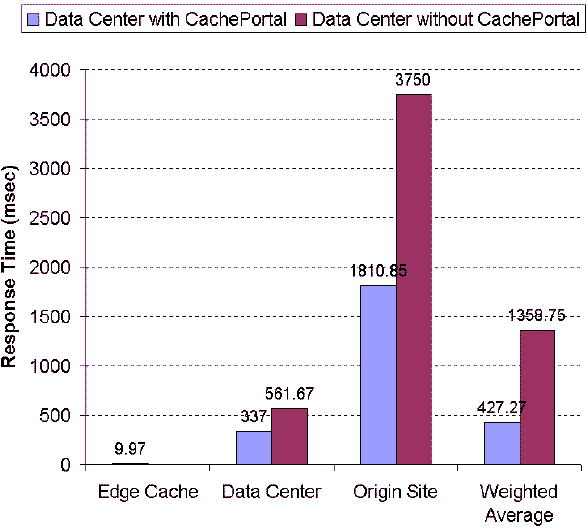
|
Figure 13: Effects of Edge Cache Hit
Rates (i.e., Number of Cached Query Types) on Weighted Average Response
Time
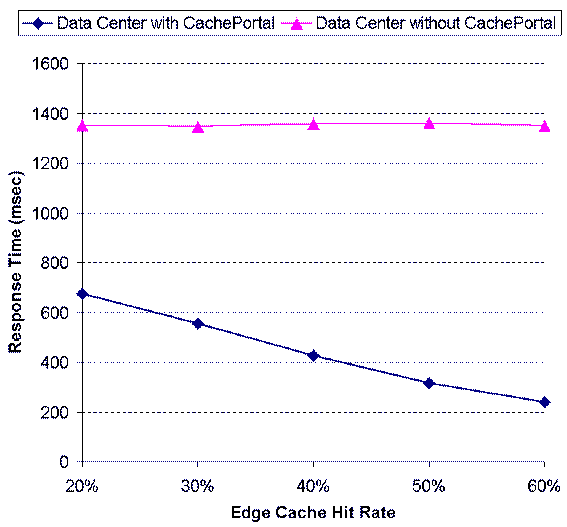
|
The next experiment we conducted is to measure the performance gain (in terms
of the response time observed by the users) achieved through our proposed
approach. In this experiment, the baseline setting is used (i.e., database
update rate is 600 tuples per table per minute; the network latency is 250 ms
round trip; the number of cached query types is 300; and the request rate is 100
requests per second). We set up two system configurations: (1) typical data
center architecture; and (2) data center with deployment of the CachePortal and
freshness-driven adaptive dynamic content caching. For the first system
configuration, the request rates distributed to the data center and the master
database (i.e., origin Web site) are 75 requests per second and 25 requests per
second, respectively. For the second system configuration, the request rates
distributed to the edge caches, the data center ,and the master database (i.e.,
origin Web site) are 40, 45, and 15 requests per second, respectively. The
characteristics of request distribution are described in Section 7.2
and Figure 5.
Figure 12
shows the response times measured at the edge caches, data centers, and origin
Web sites for two system configurations. These figures also show the weighted
average response time. As we can see, with deployment of CachePortal, we can
reduce the average response time by almost 70%. When the system caches 300 query
types, the edge cache hit rate reaches 40%. In Figure 13,
we show the average response time of the second system configuration with
various edge cache hit rates (from 20% to 60%). We observe that when the edge
cache hit rate increases from 20% to 60%, the average response time can be
reduced by 70%. This is because delivering dynamic content from the edge caches
is much faster than garnering content on demand. Thus, when the edge cache hit
rate increases, the weighted average response time can reduce significantly.
Figure 14: Effects of User Request Rate
on Weighted Average Response Time
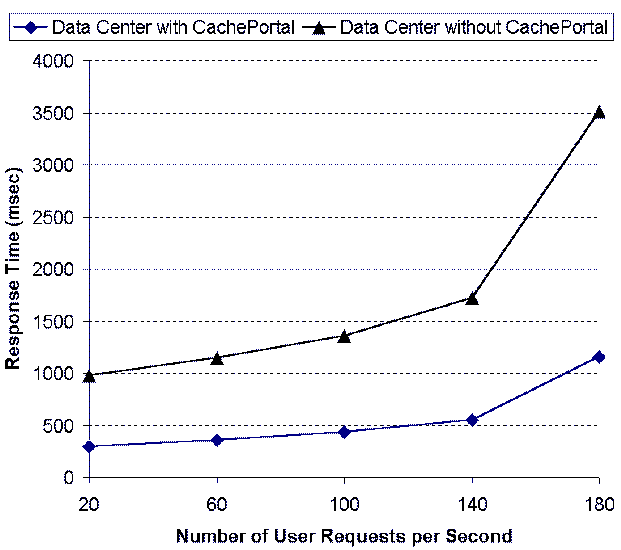
|
Figure 15: Effects of Network Latency
on Weighted Average Response Time
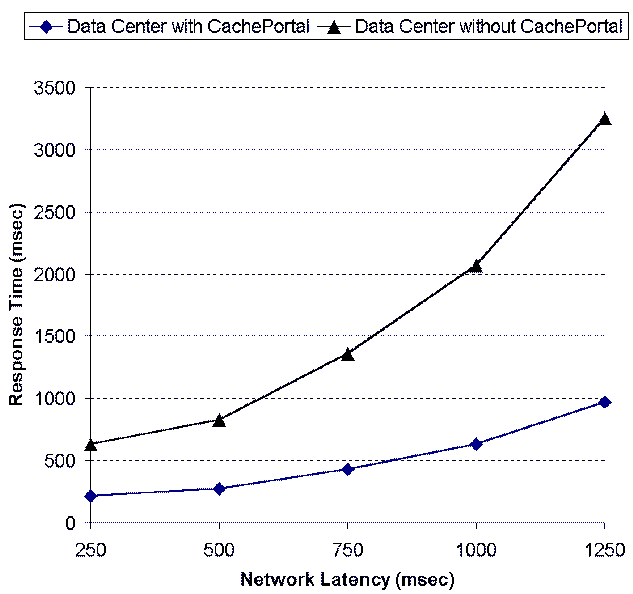
|
The next experiment we conducted is to measure the effects of the request
rate on response time for these two system configurations. In Figure 14,
the request rate is increased from 20 requests per second to 180 requests per
second while the other parameters remain the same. As we can see, when the
request load to the system increases 8 times, the average response time of the
first system configuration increases 3.5 times, which indicates that the data
center architecture is reasonably scalable. On the other hand, we see that the
average response time by the data center architecture with deployment of
Cacheportal (i.e., the second system configuration) increases at a slower
rate.
We also measure the effects of network latency on the average response time.
We increase the network latency between the data center and the origin Web site
(the master database) from 250 ms to 1250 ms. We observe the the second system
configuration is less sensitive to the network latency as the average response
time increases at a slow rate as shown in Figure 15.
This is because the data center architecture with deployment of Cacheportal
serves a higher percentage of requests from the edge than the typical data
center architecture.
Figure 16: Effects of Update Rate on
Invalidation Overhead
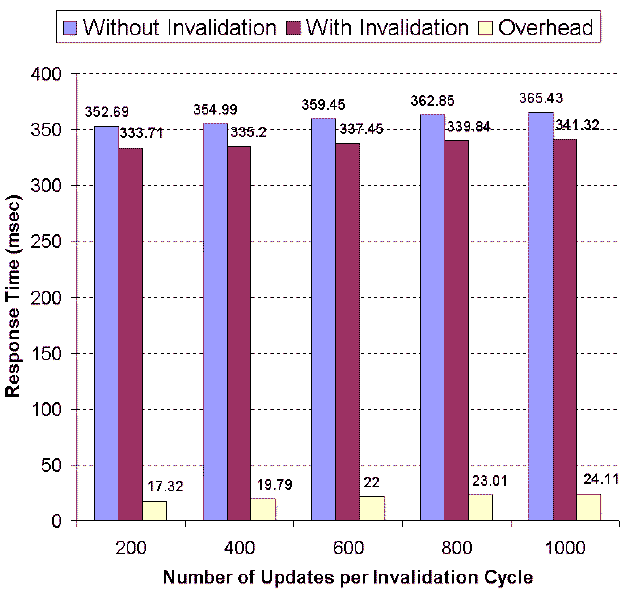
|
Figure 17: Effects of Cached Query
Types on Invalidation Overhead
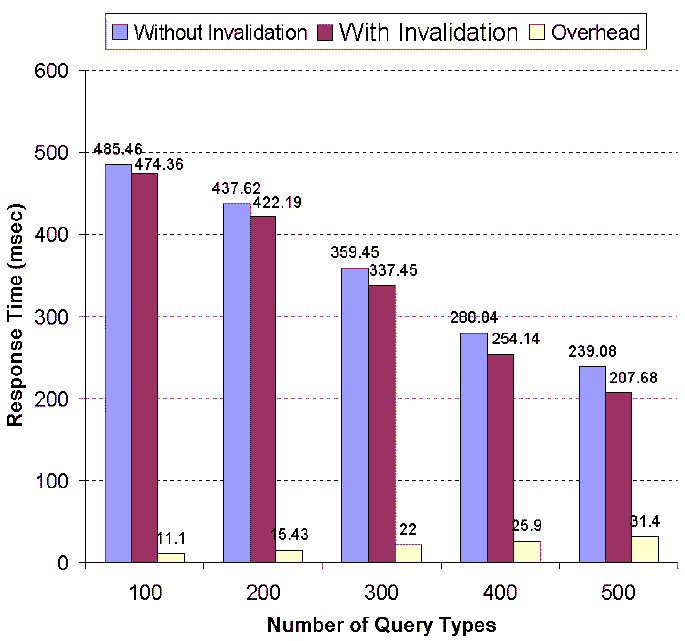
|
In Section 6,
we have analytically concluded that the invalidation cycle is mainly impacted by
the number of cached query types, and that database update rates have relatively
lower impact on the length of the invalidation cycle. We have conducted
experiments to validate our analysis.
Figures 16
and 17
show the results for the evaluation of the scalability of our proposed
solutions. We first look at the effects of the update rate on invalidation
overhead. As shown in Figure 16,
the update rate has an impact on the computing time of polling queries in the
invalidation as well as synchronization time. Since the polling queries are
submitted to the same machine and since appropriate indexing schemes are used,
the impact of the increase in the update rate is limited.
We also evaluate the effects of the number of cached query types on the
invalidation overhead. The number of cached query types determines the number of
polling queries that need to be executed; however, the computation cost of each
polling query remains the same. Since the polling queries are submitted to the
same machine, the impact of the increase in cached query types is limited,
although the effect of the number of cached query types is more notable than the
effect of database update rate. This is shown in Figure 17.
We can see that as we increase the number of cached query types, the reduction
of response time is much higher than the increase of invalidation overhead.
Related Work
Applying caching
solutions for Web applications and content distribution has received a lot of
attention in the Web and database communities[7,8,9,10,11,12,3].
These provide various solutions to accelerate content delivery as well as
techniques to assure the freshness of the cached pages. Note that since Web
content is delivered through the Internet, the content freshness can only be
assured rather than being guaranteed. WebCQ [13]
is one of the earliest prototype systems for detecting and delivering
information changes on the Web. However, the change detection is limited to
ordinary Web pages. Yagoub et al. [14]
have proposed caching strategies for data intensive Web sites. Their approach
uses materialization to eliminate dynamic generation of pages but does not
address the issue of view invalidation when the underlying data is updated.
Labrindis and Roussopoulos [15]
present an innovative approach to enable dynamic content caching by maintaining
static mappings between database contents and Web pages, and therefore
requires a modification to underlying Web applications. Dynamai [4]
from Persistence Software is one of the first dynamic caching solution that is
available as a product. However, Dynamai relies on proprietary software for both
database and application server components. Thus it cannot be easily
incorporated into existing e-commerce framework. Levy et al. [5]
at IBM Research have developed a scalable and highly available system for
serving dynamic data over the Web. The IBM system was used at Olympics 2000 to
post sport event results on the Web in timely manner. This system utilizes
database triggers to generate update events as well as intimately relying on the
semantics of the application to map database update events to appropriate Web
pages. Heddaya and Mirdad [16],
where authors propose a diffusion-based caching protocol that achieves
load-balancing, [17]
which uses meta-information in the cache-hierarchy to improve the hit ratio of
the caches, [18]
which evaluates the performance of traditional cache hierarchies and provides
design principles for scalable cache systems, and [19]
which highlights the fact that static client-to-server assignment may not
perform well compared to dynamic server assignment or selection. SPREAD [20],
a system for automated content distribution, is an architecture which uses a
hybrid of client validation, server invalidation, and
replication to maintain consistency across servers. Note that the work
in [20]
focuses on static content and describes techniques to synchronize static
content, which gets updated periodically, across Web servers. Therefore, in a
sense, the invalidation messages travel horizontally across Web servers.
Concluding Remarks
In this paper, we
propose a freshness-driven adaptive dynamic content caching technique
that maintains the best content freshness that an application-hosting data
center configuration can support. The technique monitors the response time and
the length of the invalidation cycle and dynamically adjusts the caching policy
accordingly. By balancing invalidation cycle length and response time our
technique is able to maintain the best content freshness that can be assured.
The experiments validate the effectiveness of our technique. Under heavy
traffic, the freshness-driven adaptive caching supports content freshness up to
20 times better than those data center-hosted applications without dynamic
content caching. It also supports content freshness up to 7 times better than
those data center-hosted applications that deploy dynamic content caching
solutions. Furthermore, our approach also provides faster response times and
better scalability.
- 1
- Akamai Technology.
http://www.akamai.com/.
- 2
- B. Krishnamurthy and C.E. Wills.
Analyzing factors that influence
end-to-end web performance.
In Proceedings of the 9th World-Wide Web
Conference, pages 17-32, Amsterdam, The Netherlands, May 2000.
- 3
- K. Selcuk Candan, Divyakant Agrawal, Wen-Syan Li, Oliver Po, and
Wang-Pin Hsiung.
View Invalidation for Dynamic Content Caching in
Multitiered Architectures .
In Proceedings of the 28th Very Large Data
Bases Conference, Hong Kong, China, August 2002.
- 4
- Persistent Software Systems Inc.
http://www.dynamai.com/.
- 5
- Eric Levy, Arun Iyengar, Junehwa Song, and Daniel Dias.
Design and
Performance of a Web Server Accelerator.
In Proceedings of the IEEE
INFOCOM'99, New York, New York, March 1999. IEEE.
- 6
- Wen-Syan Li, Wang-Pin Hsiung, Dmitri V. Kalashnikov, Radu Sion,
Oliver Po, Divyakant Agrawal, and K. Selçuk Candan.
Issues and
Evaluations of Caching Solutions for Web Application Acceleration.
In
Proceedings of the 28th Very Large Data Bases Conference, Hong Kong,
China, August 2002.
- 7
- Ben Smith, Anurag Acharya, Tao Yang, and Huican Zhu.
Exploiting Result
Equivalence in Caching Dynamic Web Content.
In Proceedings of USENIX
Symposium on Internet Technologies and Systems, 1999.
- 8
- P. Deolasee, A. Katkar, A. Panchbudhe, K. Ramamritham,
and P. Shenoy.
Adaptive Push-Pull: Dissemination of Dynamic Web
Data.
In the Proceedings of the 10th WWW Conference, Hong Kong,
China, May 2001.
- 9
- C. Mohan.
Caching Technologies for Web Applications.
In
Proceedings of the 2001 VLDB Conference, Roma, Italy, September 2001.
- 10
- Anoop Ninan, Purushottam Kulkarni, Prashant Shenoy, Krithi Ramamritham,
and Renu Tewari.
Cooperative Leases: Scalable Consistency Maintenance in
Content Distribution Networks.
In Proceedings of the 2002 World-Wide
Web Conference, Honolulu, Hawaii, USA, May 2002.
- 11
- Anindya Datta, Kaushik Dutta, Helen M. Thomas, Debra E.
VanderMeer, Suresha, and Krithi Ramamritham.
Proxy-Based Acceleration of
Dynamically Generated Content on the World Wide Web: An Approach and
Implementation.
In Proceedings of 2002 ACM SIGMOD Conference,
Madison, Wisconsin, USA, June 2002.
- 12
- Qiong Luo, Sailesh Krishnamurthy, C. Mohan, Hamid Pirahesh, Honguk
Woo, Bruce G. Lindsay, and Jeffrey F. Naughton.
Middle-tier
Database Caching for e-Business.
In Proceedings of 2002 ACM SIGMOD
Conference, Madison, Wisconsin, USA, June 2002.
- 13
- Ling Liu, Calton Pu, and Wei Tang.
WebCQ: Detecting and Delivering
Information Changes on the Web.
In Proceesings of International
Conference on Information and Knowledge Management, Washington, D.C.,
November 2000.
- 14
- Khaled Yagoub, Daniela Florescu, Valérie Issarny, and Patrick
Valduriez.
Caching Strategies for Data-Intensive Web Sites.
In
Proceedings of the 26th VLDB Conference, Cairo, Egypt, 2000.
- 15
- A. Labrindis and N. Roussopoulos.
Self-Maintaining Web Pages
- An Overview.
In Proceedings of the 12th Australasian Database
Conference (ADC), Queensland, Australia, January/February 2001.
- 16
- A. Heddaya and S. Mirdad.
WebWave: Globally Load Balanced Fully
Distributed Caching of Hot Published Documents.
In Proceedings of the
1997 IEEE International Conference on Distributed Computing and Sytems,
1997.
- 17
- M.R. Korupolu anf M. Dahlin.
Coordinated Placement and Replacement for
Large-Scale Distributed Caches.
In Proceedings of the 1999 IEEE
Workshop on Internet Applications, 1999.
- 18
- Renu Tewari, Michael Dahlin, Harrick M. Vin, and Jonathan S.
Kay.
Design Considerations for Distributed Caching on the Internet.
In
Proceedings of the 19th International Conference on Distributed Computing
Systems, 1999.
- 19
- R.L. Carter and M.E. Crovella.
On the network impact of dynamic server
selection.
Computer Networks, 31(23-24):2529-2558, 1999.
- 20
- P.Rodriguez and S.Sibal.
Spread: Scaleable platform for reliable and
efficient automated distribution.
In Proceedings of the 9th World-Wide
Web Conference, pages 33-49, Amsterdam, The Netherlands, May 2000.







